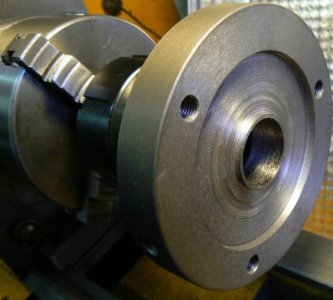- Joined
- Dec 25, 2011
- Messages
- 10,552
Ed,
Short answer is yes, if the 1"-8 female threads on the back of the chuck come all the way out to the surface, they must be cut away. The problem is that the counterbore is what centers up the chuck to the spindle. So it MUST be concentric with the jaws. If the jaws are in good condition, what I would do is to take a piece of precision ground steel solid round just small enough to fit through the hole in the front chuck body and mount it in a 4-jaw and indicate it in to zero TIR. Then clamp the chuck to the round with its jaws.
But before we get into that, it still isn't clear to me whether the chuck is a solid-back, as most were, or has a back-plate. Easiest way to answer that is to take and post rear and side view photos of the chuck. I can't understand why the back of the chuck (whichever variant it is) doesn't have the register counterbore as I can't imagine it shipping from the factory like that.
Short answer is yes, if the 1"-8 female threads on the back of the chuck come all the way out to the surface, they must be cut away. The problem is that the counterbore is what centers up the chuck to the spindle. So it MUST be concentric with the jaws. If the jaws are in good condition, what I would do is to take a piece of precision ground steel solid round just small enough to fit through the hole in the front chuck body and mount it in a 4-jaw and indicate it in to zero TIR. Then clamp the chuck to the round with its jaws.
But before we get into that, it still isn't clear to me whether the chuck is a solid-back, as most were, or has a back-plate. Easiest way to answer that is to take and post rear and side view photos of the chuck. I can't understand why the back of the chuck (whichever variant it is) doesn't have the register counterbore as I can't imagine it shipping from the factory like that.

